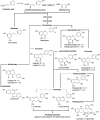Polyphenols and the human brain: plant “secondary metabolite” ecologic roles and endogenous signaling functions drive benefits
- PMID: 25469384
- PMCID: PMC4188223
- DOI: 10.3945/an.114.006320
Polyphenols and the human brain: plant “secondary metabolite” ecologic roles and endogenous signaling functions drive benefits
Abstract
Flavonoids and other polyphenols are ubiquitous plant chemicals that fulfill a range of ecologic roles for their home plant, including protection from a range of biotic and abiotic stressors and a pivotal role in the management of pathogenic and symbiotic soil bacteria and fungi. They form a natural part of the human diet, and evidence suggests that their consumption is associated with the beneficial modulation of a number of health-related variables, including those related to cardiovascular and brain function. Over recent years, the consensus as to the mechanisms responsible for these effects in humans has shifted away from polyphenols having direct antioxidant effects and toward their modulation of cellular signal transduction pathways. To date, little consideration has been given to the question of why, rather than how, these plant-derived chemicals might exert these effects. Therefore, this review summarizes the evidence suggesting that polyphenols beneficially affect human brain function and describes the current mechanistic hypotheses explaining these effects. It then goes on to describe the ecologic roles and potential endogenous signaling functions that these ubiquitous phytochemicals play within their home plant and discusses whether these functions drive their beneficial effects in humans via a process of “cross-kingdom” signaling predicated on the many conserved similarities in plant, microbial, and human cellular signal transduction pathways.
Conflict of interest statement
Author disclosures: D. O. Kennedy, no conflicts of interest.
Figures


Similar articles
-
Dietary and plant polyphenols exert neuroprotective effects and improve cognitive function in cerebral ischemia.Recent Pat Food Nutr Agric. 2013 Aug;5(2):128-43. doi: 10.2174/1876142911305020003. Recent Pat Food Nutr Agric. 2013. PMID: 23621667 Review.
-
Dietary polyphenols as modulators of brain functions: biological actions and molecular mechanisms underpinning their beneficial effects.Oxid Med Cell Longev. 2012;2012:914273. doi: 10.1155/2012/914273. Epub 2012 Jun 3. Oxid Med Cell Longev. 2012. PMID: 22701758 Free PMC article. Review.
-
Potential for preventive effects of cocoa and cocoa polyphenols in cancer.Food Chem Toxicol. 2013 Jun;56:336-51. doi: 10.1016/j.fct.2013.02.020. Epub 2013 Feb 22. Food Chem Toxicol. 2013. PMID: 23439478 Review.
-
Natural mood foods: the actions of polyphenols against psychiatric and cognitive disorders.Nutr Neurosci. 2012 May;15(3):127-33. doi: 10.1179/1476830511Y.0000000035. Epub 2012 Jan 17. Nutr Neurosci. 2012. PMID: 22334236 Free PMC article. Review.
-
A Critical Review on Polyphenols and Health Benefits of Black Soybeans.Nutrients. 2017 May 4;9(5):455. doi: 10.3390/nu9050455. Nutrients. 2017. PMID: 28471393 Free PMC article. Review.
Cited by
-
Longevity extension by phytochemicals.Molecules. 2015 Apr 13;20(4):6544-72. doi: 10.3390/molecules20046544. Molecules. 2015. PMID: 25871373 Free PMC article. Review.
-
Evaluation of in vivo antidiabetic, antidyslipidemic, and in vitro antioxidant activities of hydromethanolic root extract of Datura stramonium L. (Solanaceae).J Exp Pharmacol. 2019 Apr 23;11:29-38. doi: 10.2147/JEP.S192264. eCollection 2019. J Exp Pharmacol. 2019. PMID: 31114400 Free PMC article.
-
Antioxidant therapies in traumatic brain injury.Neurochem Int. 2022 Jan;152:105255. doi: 10.1016/j.neuint.2021.105255. Epub 2021 Dec 13. Neurochem Int. 2022. PMID: 34915062 Free PMC article.
-
Epigallocatechin-3-gallate confers protection against corticosterone-induced neuron injuries via restoring extracellular signal-regulated kinase 1/2 and phosphatidylinositol-3 kinase/protein kinase B signaling pathways.PLoS One. 2018 Jan 26;13(1):e0192083. doi: 10.1371/journal.pone.0192083. eCollection 2018. PLoS One. 2018. PMID: 29373584 Free PMC article.
-
Acute and Chronic Effects of Green Oat (Avena sativa) Extract on Cognitive Function and Mood during a Laboratory Stressor in Healthy Adults: A Randomised, Double-Blind, Placebo-Controlled Study in Healthy Humans.Nutrients. 2020 May 29;12(6):1598. doi: 10.3390/nu12061598. Nutrients. 2020. PMID: 32485993 Free PMC article. Clinical Trial.
References
-
- Dewick PM. Medicinal natural products: a biosynthetic approach. Chichester, UK: John Wiley and Sons; 2009
-
- Chun OK, Chung SJ, Song WO. Estimated dietary flavonoid intake and major food sources of us adults. J Nutr 2007;137:1244–52 - PubMed
-
- Zamora-Ros R, Andres-Lacueva C, Lamuela-Raventós RM, Berenguer T, Jakszyn P, Barricarte A, Ardanaz E, Amiano P, Dorronsoro M, Larrañga N, Martínez C, Sánchez MJ, Navarro C, Chirlaque MD, Tormo MJ, Quirós JR, González CA. Estimation of dietary sources and flavonoid intake in a spanish adult population (EPIC-spain). J Am Diet Assoc 2010;110:390–8 - PubMed
-
- Johannot L, Somerset SM. Age-related variations in flavonoid intake and sources in the australian population. Public Health Nutr 2006;9:1045–54 - PubMed
-
- Ovaskainen M-L, Torronen R, Koponen JM, Sinkko H, Hellstrom J, Reinivuo H, Mattila P. Dietary intake and major food sources of polyphenols in Finnish adults. J Nutr 2008;138:562–6 - PubMed
Publication types
MeSH terms
Substances
LinkOut - more resources
Full Text Sources
Other Literature Sources

